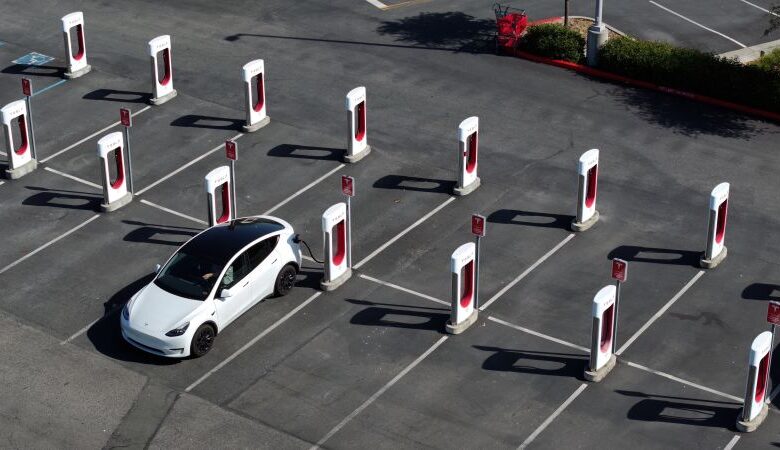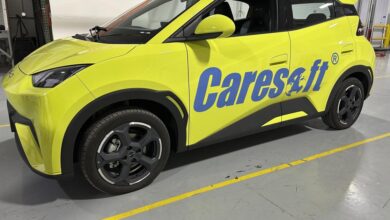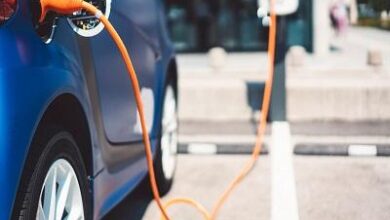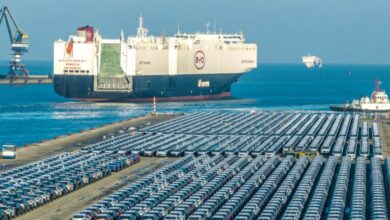Tesla slashed its Supercharger team. What does that mean for America’s EV network?

Justin Sullivan/Getty Images
A Tesla Supercharger station in Petaluma, California.
CNN
—
The news this week that Elon Musk laid off Tesla’s entire Supercharger team sent shockwaves of uncertainty through the industry tasked with building America’s new network of EV chargers.
A fast and reliable charging network is an essential ingredient in getting more people to switch from gas-powered vehicles to electric, and some early types of chargers proved less than dependable. Tesla had a superior charging network long before President Joe Biden set an ambitious goal to install half a million stations around the US by the end of the decade.
Until recently, Tesla played a central role in that plan. Many EV experts and drivers think Tesla’s chargers are fast and reliable, so much so that other car companies are adapting their charging plugs to fit Tesla’s system.
Tesla has been awarded more federal contracts for charging stations than any other company – $28 million-worth – which comprises about 14% of the total awards, according to data from EVAdoption, a data consulting firm. But with Musk firing the entire Supercharger team as part of broader company cost-cutting, it’s unclear whether Tesla will be able to complete the work, or if the contracts will ultimately get awarded to other companies.
A spokesperson for the Joint Office of Energy and Transportation, which runs the National Electric Vehicle Infrastructure program, or NEVI, said 10 states have selected Tesla as a charging provider for their projects. NEVI was unable to comment on whether Tesla could fulfill the contracts, as the charging programs themselves are run by individual states.
“Because NEVI provides grants to states, which run competitive procurements to select vendors, we don’t expect individual business decisions to impact EV charging projects funded by the Bipartisan Infrastructure Law,” the spokesperson told CNN in an email. “We are focused on delivering a positive charging experience for every driver and an even playing field for American companies.”
Others in the industry said the possible loss of Tesla wouldn’t be a huge blow.
“There are many, many charging companies out there,” an EV industry source told CNN. “It’s not like that money was going to Tesla or it was going nowhere. It’s going to change potentially who is going to receive those rewards.”
Musk’s decision to eliminate his company’s charging team has been even more baffling to industry insiders given the amount of federal money the company received, and how long Tesla had been in the business of charging.
“Charging is a difficult business, there’s no doubt about that,” the EV industry source said. “The margins are very slim and it’s quite cutthroat. They were ahead of the game, so it does strike me as odd to relinquish that a little bit.”
Since it rolled out the network in 2012, Tesla has built a reputation for having the most reliable chargers, but experts said the company’s chaos may prompt competitors to step up their offerings – democratizing US charging infrastructure in the process.
“In the end it’s probably a plus because it’s not in the public interest to have one company be so dominant,” Daniel Sperling, founding director of the Institute of Transportation Studies at the University of California Davis, told CNN. “The good news is it’s going to motivate all these other charging companies and [automakers] to redouble their investment creating a reliable expanded charging system.”
And the very fact that there are so many more players in the field of EV charging may have been one of the things that caused Musk to pull back significantly from the field, EV industry analyst Loren McDonald said.
“With NEVI funding going to build out charging deserts in upstate New York, the prairies of the Midwest, and deserts of the southwest – he probably realized that Tesla should focus on where the majority of EV sales are happening and continuing to grow,” McDonald, the CEO of EVAdoption, told CNN in an email. “Tesla can slow down a bit, be much more strategic and finally put some of the investment and responsibility on the shoulders of others.”



